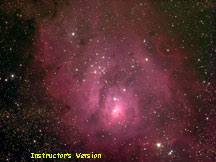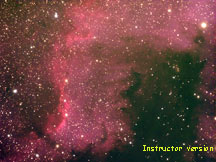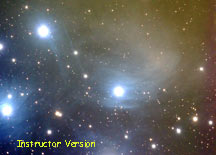Astro 9 - Fall '07 Dark Sky Trip
to Bonny Doon
Oct 13, 2007
Our class meet on the evening of
Saturday, Oct 13 at the Santa Cruz Astronomy Club's twice monthly starparty
at Bonny Doon Airfield. Skies were clear, but damp from yesterday's rain. Chris
Angelos and I tried to find Comet F1 LONEOS but it was already too low by the
time the sky was dark enough to see well. I brought along the 8" f/4 and
ST2000XCM for optimal imaging, and also the LXD75 mount + oak board for helping
students get some guided pictures.
Alerted by Sharahm, I did a doublecheck
on Comet F1 LONEOS and found it would be 6 degrees up in the northwest when
the sun was -12; perhaps barely above the redwoods in a barely dark enough sky
to grab some sort of photo? So I quickly air popped some popcorn, grabbed my
bottle of almonds, and headed up; if I hurried I could get set up by 7:30pm.
Kevin arrived right after sunset, even before I did. Ridell and Sakaya arrived
next. Chris Angelos and about a half dozen of the other SCAC members were already
setting up when I arrived. Chris A. and I tried valiantly to find the comet,
but it was just too low into the trees by the time it was dark enough to find
in binoc's. We never did see it. My plan for digital photography was to take
charge of that myself, and allow each of the students to help execute the photographs
so that each student who participated could claim some joint ownership and have
fun digitally polishing their prize one their own later. I was very concerned
with efficiency because we did not have AC power and because I expected heavy
dew. Our little 12v dew gun was going to zap our batteries quickly. If we could
keep it up till midnight before flameout I'd declare victory and cut/and/run.
Below, I'm posting my own versions of the 3 deep sky wonders photographed with
the 8" f/4 + GM8 + ST2000xcm. I'm 'watermarking' each for now, to distinguish
from later student-generated versions. I quickly got set up on the Lagoon Nebula,
which was in the darkest part of the sky but would not remain up for long. Then,
the North America Nebula's "mexico" area, and then Chris arrived and
requested a nebula or galaxy subject; I settled on the Plieades.
We were humming along getting target
after target, both on the LXD platform and with the ST2000xcm, and students
with individual tripod opportunities. But dew indeed settled in on us, and at
one point I plugged our dew gun through the fused connector powering the LXD
75 mount - and fried the fuse. I keep my fuses with the 10" LX200 case.
Doh! No more guided wide-angle shots. Still, students followed suggestions in
getting creative with foreground opportunities / background stars using tripod
alone. By midnight, my computer battery and backup were all pooped out, and
I was only able to finish the last 5 minute frame on the Plieades by AC inverter
powering the computer - an extremely inefficient solution, and the gel battery
quickly complained about low battery draw every time I had to use the dew gun
on this same battery. Yet, in total, we prevailed - and the night was a big
success.
As inspiration for the Astro 9er's
to dig in and massage the raw photos to their own vision of perfection, I'm
including my own efforts below. Each took about 10-15 minutes of work, and I
think they are quite fine, thank you! Each uses CCDOPS5, dark subtracted but
no flat field, sRGB+gamma single-shot color processed, then stacked in Registax
3, and fine tuned in Photoshop CS2 with help from Astronomy Tools Photoshop
actions ver 1.4 (in quotes).

The Lagoon Nebula. 5x5min = 25 minute stack The nebula
was low in the southwest, only 15 degrees up, and color separation due
to refraction is evident on the brighter stars. Photoshop CS2: levels,
saturation, smart sharpen (gaussian). AstroTools: 4x 'make stars smaller',
'deep space noise reduction', 'space noise reduction', re-leveled. Compare
this fine photo with one I took using the 80mm
f/6 Megrez refractor, under perfect high Sierra conditions. The
bigger, faster Meade 8" f/4 here is the easy winner, plus more
experience with Photoshop.
|

The North America Nebula, "Mexico" Region.
9x5min stack = 45 minutes. Photoshop CS2: levels, smart sharpen (gaussian),
Astro Tools: 2x 'make stars smaller', 2x 'space noise reduction', levels,
saturation.
|

The Plieades. 7x5min stack, composed by Chris, of
the Plieades showing both the blue dust reflections and also the red
H-alpha cloud near Merope. South is up and right. I made generous use
of Photoshop CS2 (levels, saturation, unsharp mask + Astronomy Tools
actions: 3x 'make stars smaller', 'space noise reduction', 'deep space
noise reduction'
|
Eventually the student versions will
be posted here, so check back towards the end of the semester.


